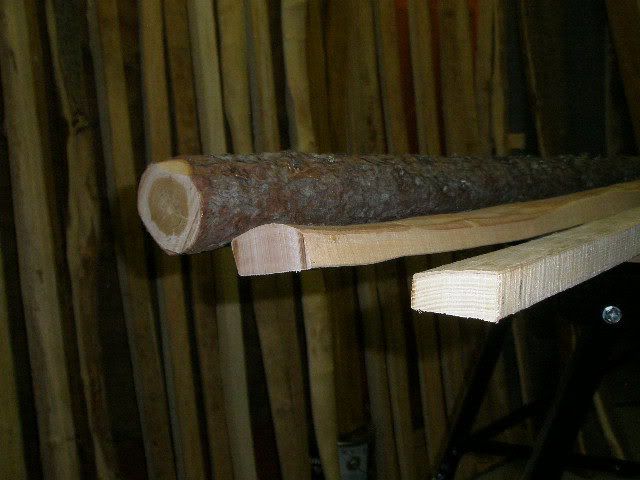|
|
Post by archeryman57 on Jan 18, 2008 0:37:59 GMT -4
I put a couple of staves on my bench, because it is time to try to build a new bow. I have a nice piece of yellow birch, a short white ash stave (that will make a youth bow) and a sappling of Larch. I think the ash is calling the loudest.
|
|
|
|
Post by huntwisely on Jan 20, 2008 16:57:48 GMT -4
 Larch, Birch and Ash staves  Larch, Birch and Ash staves - ends |
|
|
|
Post by ARROW SLINGER on Jan 21, 2008 0:09:23 GMT -4
What kind of stick does that Larch AKA-Tamarak make? I know where I can get plenty of that!
|
|
|
|
Post by archeryman57 on Jan 21, 2008 13:40:02 GMT -4
The larch is new to me AS, but it is used by other bowyers.
|
|
|
|
Post by archeryman57 on Jan 21, 2008 13:53:01 GMT -4
|
|
|
|
Post by ARROW SLINGER on Jan 21, 2008 18:53:55 GMT -4
I got a question about staves!
Do they have to be split to follow the belly grain or can they be sawn?
Is it a technical thing (checking/twisting) or just tradition?
And should they be left standing or on their backs/belly to dry?
|
|
|
|
Post by archeryman57 on Jan 21, 2008 20:57:42 GMT -4
Staves are usually split to follow the grain. They can be sawn if you are careful to follow the grain. The birch stave in the photo is one that I cut on a band scroll saw after marking the lines of the grain. Checking is something that happens when the wood dries unevenly. The wood that is put in stress will tend to check. The checking happens the most on the ends and can be cut off most times. Painting the ends of the wood with paint or wood glue will stop the checking some. I think that you can store the wood whichever way. What I like to do is tie two staves back to back with a block in the center to put a bit of backset in when they are dry. If you have only one stave to dry then just tie it to a 2x4 and use the 2x4 as the form. The ash stave that I chose to use was cut from a stick of slabwood. The slab was extra thick and this allowed me to bandsaw the stave or most times 4 or 5 staves from one slab.  |
|
|
|
Post by POINTY STICKS on Jan 21, 2008 21:21:15 GMT -4
I think I'm going to like this thread. Might even post a couple pictures on it myself ;D
|
|
|
|
Post by archeryman57 on Jan 21, 2008 21:40:06 GMT -4
Please join in Pointy. The stick needs to have the center line marked so that I can layout the back of the bow.  Now that the string is in place, I can mark the points of the line.  The point at the handle of the bow is marked and then the ends.   |
|
|
|
Post by archeryman57 on Jan 22, 2008 21:21:57 GMT -4
Now that the dots are marked for the center it is easy to put the straight edge on and connect them. We can now layout the back of the bow. Mark the C-line of stick and make the handle 4".   marks on ends  |
|
|
|
Post by ARROW SLINGER on Jan 24, 2008 12:10:18 GMT -4
The C/L off-set for the 4" handle mark? longer upper limb?
No shelf traditional round handle?
|
|
|
|
Post by archeryman57 on Jan 24, 2008 12:58:20 GMT -4
The longer upper limb is used becaue the bow will be shot with two fingers under the arrow. This allows the arrow to come up as it is clearing the bow. I do not cut a shelf in the wood, but glue a shelf on with leather.    |
|
|
|
Post by archeryman57 on Jan 24, 2008 13:32:21 GMT -4
This is what it looks like after sawing to lines.    It is now time to peel the inner bark from stick.  Getting close now so I will use a homemade scraper.  This flat bar srcaper gets the high spots and next I use a convex one to get the low grooves.  I am leaving a thin bit of cambium for colour.  |
|
alpo
Full Member
  
Posts: 157
|
Post by alpo on Jan 24, 2008 14:22:45 GMT -4
was the picking of the top limb arbitrary on this stave ?
I usually work in from the tips in & cut the handle area later, after it's bending some, sometimes adjusting center as obstacles or character features dictates..... or more often to correct for one of my mistakes
|
|
|
|
Post by archeryman57 on Jan 24, 2008 14:43:08 GMT -4
This ash stave is very even for the length, so there is not much diff if I put one end up or down. For a stave that has a lot of character then you may want to pick one end over the other as the top or bottom. In the past I have built bows that were equal length limbs and then as I was tillering it I would pick the top limb by looking at the string to see which side of the handle it was on, and choosing the way the bow looked for a right or left hand shooter. This requires more of a challenge when it comes to the tillering.
|
|